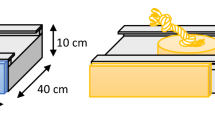Abstract
Very little is known about the social learning of orangutans (Pongo pygmaeus), especially in the context of problem-solving situations such as tool use. Sixteen orangutans were presented with a rake-like tool and desirable but out-of-reach food. Eight subjects observed a human demonstrator use the tool in one way, while another eight observed the demonstrator use the tool in another way. Subjects behaved identically in the two experimental conditions, showing no effect of the type of demonstration observed. Analysis of individual learning curves suggested that a large component of individual trial-and-error learning was at work, even for two subjects who received additional trials with an orangutan demonstrator. This pattern of results suggests that subjects were paying attention to the general functional relations in the task and to the results obtained by the demonstrator, but not to the actual methods of tool use demonstrated. It is concluded that subjects in both conditions were employing emulation learning, not imitative learning.
Similar content being viewed by others
References
Boesch, C., 1993.New perspectives on culture in wild chimpanzees. Behavioral and Brain Sciences, 16: 514–15.
Cheney, D. & Seyfarth, R., 1990.How monkeys see the world, Chicago. U. of Chicago Press.
Galef, B., 1990. Tradition in animals: field observations and laboratory analyses. In (M. Beckoff & D. Jamieson, eds.)Interpretations and explanations in the study of behavior: Comparative perspectives, pp. 74–95. Boulder: Westview Press.
Haggerty, M., 1913.Plumbing the minds of apes. McClure's Magazine, 41: 151–54.
Hayes, K. & Hayes, C., 1952.Imitation in a home-raised chimpanzee. Journal of comparative and physiological psychology, 45: 450–59.
Kohler, W., 1927.The mentality of apes. London: Routledge and Kegan Paul.
McGrew, W., 1992.Chimpanzee material culture. Cambridge. Cambridge University Press.
Miles, L., 1990.The cognitive foundations for reference in a signing orangutan. In (S. Parker & K. Gibson, eds.) “Language” and intelligence in Monkeys and apes: Comparative developmental perspectives, pp. 511–539. Cambridge: Cambridge University Press.
Miles, L., Mitchell, R. & Harper, S., 1992.Imitation and self-awareness by a signing orangutan. Paper presented to the International Primatological Society, Strasbourg, France.
Nagell, K., Olguin, K. & Tomasello, M., 1993.Processes of social learning in the tool use of chimpanzees and human children. Journal of Comparative Psychology, 107: 174–85.
Paquette, D., 1992.Discovering and learning tool use for fishing honey by captive chimpanzees. Human Evolution, 7: 17–30.
Premack, D. & Dasser, V., 1991.Perceptual origins and conceptual evidence for theory of mind in apes and children. In (A. Whiten, ed.), Natural theories of mind: Evolution, development, and simulation of everyday mindreading, pp. 253–266. London, Blackwell.
Russon, A. & Galdikas, B., 1993.Imitation in ex-captive orangutans. Journal of Comparative Psychology, 107: 159–73.
Shepherd, W., 1923.Some observations and experiments of the intelligence of the chimpanzee and orang. American Journal of Psychology, 34: 590–91.
Thorpe, W., 1956.Learning and instinct in animals. London: Methuen.
Tomasello, M., 1990.Cultural transmission in the tool use and communicatory signaling of chimpanzees? In (S. Parker & K. Gibson, eds.) “Language” and intelligence in Monkeys and apes: Comparative developmental perspectives, pp. 274–311. Cambridge: Cambridge University Press.
Tomasello, M., Call, J., Nagell, K., Olguin, K., & Carpenter, M., 1994.The learning and use of gestural signals by young chimpanzees: A trans-generational study. Primates, 35(2): 137–154.
Tomasello, M., Davis-Dasilva, M., Camak, L., & Bard, K., 1987.Observational learning of tool use by young chimpanzees. Human Evolution, 2: 175–183.
Tomasello, M., Kruger, A., & Ratner, H., 1993.Cultural learning. Behavioral and Brain Sciences, 16: 495–552.
Tomasello, M., Savage-Rumbaugh, S., & Kruger, A., 1993.Imitative learning of object-directed actions by chimpanzees, enculturated chimpanzees, and human children. Child Development, 64, 1688–1705.
Visalberghi, E. & Fragaszy, D..Do monkeys ape?, 1990. In (S. Parker & K. Gibson, eds.) “Language” and intelligence in monkeys and apes: Comparative developmental perspectives (pp. 247–273) Cambridge: Cambridge University Press.
Whiten, A. & Ham, R., 1992.On the nature and evolution of imitation in the animal kingdom: Reappraisal of a century of research. In (P. Slater & J. Rosenblatt, eds.), Advances in the study of behavior, pp. 239–283. New York: Academic Press.
Wright, R., 1972.Imitative learning of a flaked stone technology. The case of an orangutan. Mankind, 8: 296–306.
Yerkes, R., 1916.The mental life of monkeys and apes. Behavior Monographs, Volume 3, New York: Holt.
Zentall, T. & Galef, B. (eds.), 1988.Social learning. Hillsdale, N. J.: Erlbaum.
Author information
Authors and Affiliations
Rights and permissions
About this article
Cite this article
Call, J., Tomasello, M. The social learning of tool use by orangutans (Pongo pygmaeus). Hum. Evol. 9, 297–313 (1994). https://doi.org/10.1007/BF02435516
Received:
Accepted:
Issue Date:
DOI: https://doi.org/10.1007/BF02435516




